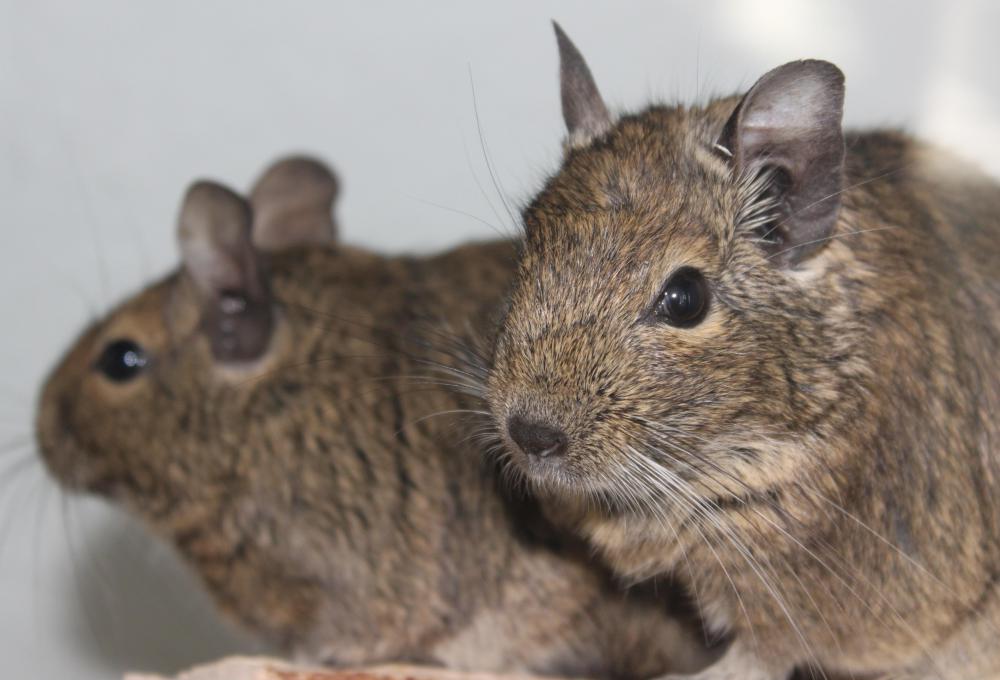At AllThingsNature, we're committed to delivering accurate, trustworthy information. Our expert-authored content is rigorously fact-checked and sourced from credible authorities. Discover how we uphold the highest standards in providing you with reliable knowledge.
What Is an Octodon?
The Octodon genus of gerbil-like rodents are centered around the nation of Chile, running down the west coast of South America. Though three of the four family members — O. bridgesi, O. pacifica and O. lunatus — are threatened species, the remaining member of the clan, Octodon degus, can be found in plentiful numbers throughout the foothills of the Andes Mountains as well as in pet stores across the globe. Scientists have been particularly interested in this latter, so-called common degus for decades, studying its communal social order, highly developed coordination skills, and uncanny internal clocks.
Though their looks are similar, each Octodon species occupies a slightly different niche in and around Chile. The lunatus, or moon-toothed degus, tend to live along the rocky Pacific shores. Pacificus is native only to the tiny Mocha Island, off the Arauca coastline. Sticking to the mountains are the degus and bridgesi clans. The bridgesi, or Bridges' degus, stretches all the way across the Andes to Argentina, while degus stays only on Chile's western side of the mountains.

According to the International Union for Conservation of Nature and Natural Resources (IUCN), the common degus is considered a species of least concern, largely due to its prevalence both inside Chile and throughout the pet cages of the world. The three other Octodon species, however, face greater challenges. As of 2011, the IUCN considers O. pacificus a "critically endangered" species, O. bridgesi "vulnerable" and O. lunatus "near threatened." Deforestation due to agriculture or development is widely blamed for most of these declines.

Most of the Octodon species are nocturnal, though the common degus is diurnal, meaning that it sleeps at night. Perhaps this and the species' plentiful numbers are why scientists have chosen to study them the most. These animals have been used to better understand the circadian system common to mammals. This allows for environmental signals to spur biological changes like ovulation or even changes in sleeping patterns, switching from nocturnal to diurnal habits. One study even determined that degus see ultraviolet light, which allows their urine to glow and serve as a guide post.
The social order and customs of degus are centered around the burrow, which is another focus of zoological study. According to the University of Michigan's Museum of Zoology, a few males and several females will often share a single burrow, using organized burrowing chains to create a complex system of escape routes. Not only do the mothers share in breastfeeding the babies, but the males spend time huddling with the very young — without any observed infanticide.
Frequently Asked Questions
What is an Octodon, and where can it be found?
An Octodon is a small, nocturnal rodent native to South America, particularly found in the Andean mountain range. These agile creatures are known for their bushy tails and resemble squirrels in some aspects. They inhabit rocky areas and prefer environments with plenty of vegetation for cover and food sources.
How many species of Octodon are there?
There are four recognized species of Octodon: the common degu (Octodon degus), the moon-toothed degu (Octodon lunatus), the Bridges's degu (Octodon bridgesi), and the Pacific degu (Octodon pacificus). Each species has adapted to its specific habitat within the diverse ecosystems of South America.
What do Octodons eat?
Octodons are primarily herbivorous, feeding on a variety of vegetation including leaves, seeds, fruits, and flowers. Their diet is high in fiber, which is essential for their digestive system. In captivity, they require a balanced diet that mimics their natural food sources to maintain their health.
Are Octodons social animals?
Yes, Octodons are quite social and live in groups in the wild. The common degu, for example, is known for its complex social structures and behaviors. They communicate through a range of vocalizations and have been observed participating in communal activities such as grooming and play.
Can Octodons be kept as pets?
Octodons, particularly the common degu, can be kept as pets. They are known for their curious and friendly nature. However, they require a spacious enclosure, social interaction, and mental stimulation to thrive in captivity. Potential owners should research their specific needs and commit to providing a suitable environment.
What is the lifespan of an Octodon?
In the wild, Octodons typically live for about 5 to 8 years, but in captivity, with proper care, they can live up to 8 to 10 years. Their lifespan can be influenced by factors such as diet, environmental conditions, and genetics. Regular veterinary care is also crucial for maintaining their health and longevity.
AS FEATURED ON:
AS FEATURED ON:












Discuss this Article
Post your comments